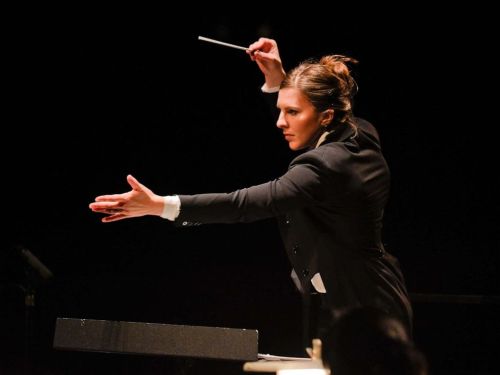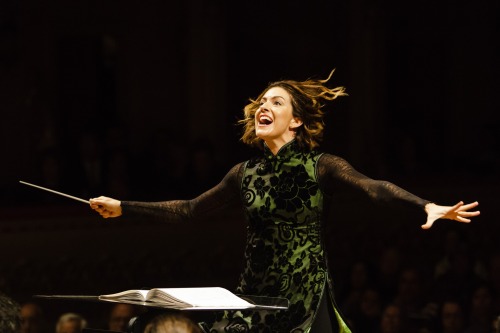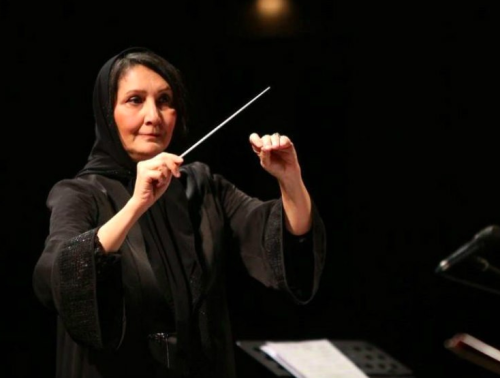I Like When An Article Thumbnail Features A Pic Of A Woman Conductor, As It Is The Closest I Will Get










I like when an article thumbnail features a pic of a woman conductor, as it is the closest I will get to living in a world where newspapers write feel-good human-interest stories about a local witch who is proud to show off her new spell.
More Posts from Dynamic-light-scattering and Others
Ave- we have the strongest person in the universe, but only use her until the last second -ngers

Saturn’s moon Titan. True color (left) and with haze-penetrating near-infrared (right) as seen by Cassini in March 2017
I'm so proud of how far did we get and mostly for a woman being the responsible for the algorithm that allowed to capture the first ever image of a black hole. GIRL POWER.
Since I’m not seeing her name nearly enough on the press, let’s give the attention Katie Bouman deserves. Thanks to her, we are now possible to see the first ever image of a black hole, something that people talked 200 years ago for the first time. It’s no longer a myth. We are girls and we can be whatever we want to be. Einstein would be proud of you, Katie. Thank you!


Here you can see a huge stack of hard drives she used for Messier 87’s black hole image data.
S.H.I.E.L.D. was founded by Peggy Carter and S.W.O.R.D. was founded by Maria Rambeau.


We stan these powerful women.
I present to you

Giovanna Crivelari, the most versatile player in Brazil













3X GRAMMY AWARD-WINNING BAND | PARAMORE 66th Annual Grammy Awards
+ bonus: first female fronted band in history to win best rock album

2019 May 1
The Cat’s Eye Nebula in Optical and X-ray Image Credit: NASA, ESA, Hubble Legacy Archive; Chandra X-ray Obs.; Processing & Copyright: Rudy Pohl
Explanation: To some it looks like a cat’s eye. To others, perhaps like a giant cosmic conch shell. It is actually one of brightest and most highly detailed planetary nebula known, composed of gas expelled in the brief yet glorious phase near the end of life of a Sun-like star. This nebula’s dying central star may have produced the outer circular concentric shells by shrugging off outer layers in a series of regular convulsions. The formation of the beautiful, complex-yet-symmetric inner structures, however, is not well understood. The featured image is a composite of a digitally sharpened Hubble Space Telescope image with X-ray light captured by the orbiting Chandra Observatory. The exquisite floating space statue spans over half a light-year across. Of course, gazing into this Cat’s Eye, humanity may well be seeing the fate of our sun, destined to enter its own planetary nebula phase of evolution … in about 5 billion years.
∞ Source: apod.nasa.gov/apod/ap190501.html
Uh can you please use your force on me?

The force is strong with this one...
-
 just-angsty-things liked this · 2 weeks ago
just-angsty-things liked this · 2 weeks ago -
 epaire liked this · 2 weeks ago
epaire liked this · 2 weeks ago -
 shayaltair liked this · 2 weeks ago
shayaltair liked this · 2 weeks ago -
 jikanet-tanaka reblogged this · 2 weeks ago
jikanet-tanaka reblogged this · 2 weeks ago -
 dreamingme reblogged this · 4 weeks ago
dreamingme reblogged this · 4 weeks ago -
 fogandfireflies liked this · 1 month ago
fogandfireflies liked this · 1 month ago -
 lucyloserdoll liked this · 2 months ago
lucyloserdoll liked this · 2 months ago -
 wwinnnryy-rockbelll liked this · 2 months ago
wwinnnryy-rockbelll liked this · 2 months ago -
 dumblrweed reblogged this · 2 months ago
dumblrweed reblogged this · 2 months ago -
 chrysanthemumpoet liked this · 2 months ago
chrysanthemumpoet liked this · 2 months ago -
 strangecollectionperson liked this · 2 months ago
strangecollectionperson liked this · 2 months ago -
 cherry-no-oujo liked this · 2 months ago
cherry-no-oujo liked this · 2 months ago -
 luzperpetua liked this · 3 months ago
luzperpetua liked this · 3 months ago -
 earlyonsetirondeficiency liked this · 3 months ago
earlyonsetirondeficiency liked this · 3 months ago -
 zeroatthebone reblogged this · 3 months ago
zeroatthebone reblogged this · 3 months ago -
 grey-gazania liked this · 3 months ago
grey-gazania liked this · 3 months ago -
 theotherwesley liked this · 3 months ago
theotherwesley liked this · 3 months ago -
 lucifers-cuvette reblogged this · 3 months ago
lucifers-cuvette reblogged this · 3 months ago -
 royalhempress reblogged this · 3 months ago
royalhempress reblogged this · 3 months ago -
 fvnkylady reblogged this · 3 months ago
fvnkylady reblogged this · 3 months ago -
 fvnkylady liked this · 3 months ago
fvnkylady liked this · 3 months ago -
 empty-paper-bag liked this · 3 months ago
empty-paper-bag liked this · 3 months ago -
 insomneiah liked this · 3 months ago
insomneiah liked this · 3 months ago -
 merecot reblogged this · 3 months ago
merecot reblogged this · 3 months ago -
 beliarrrl liked this · 3 months ago
beliarrrl liked this · 3 months ago -
 timeeaterforfun liked this · 3 months ago
timeeaterforfun liked this · 3 months ago -
 exponentialdecay reblogged this · 3 months ago
exponentialdecay reblogged this · 3 months ago -
 dumblrweed liked this · 3 months ago
dumblrweed liked this · 3 months ago -
 captainmalbrooke liked this · 3 months ago
captainmalbrooke liked this · 3 months ago -
 saltball reblogged this · 3 months ago
saltball reblogged this · 3 months ago -
 jikanet-tanaka liked this · 3 months ago
jikanet-tanaka liked this · 3 months ago -
 oldblush reblogged this · 3 months ago
oldblush reblogged this · 3 months ago -
 mmisccc liked this · 3 months ago
mmisccc liked this · 3 months ago -
 misakikaito reblogged this · 3 months ago
misakikaito reblogged this · 3 months ago -
 itsnotzka liked this · 3 months ago
itsnotzka liked this · 3 months ago -
 andordean reblogged this · 3 months ago
andordean reblogged this · 3 months ago -
 andordean liked this · 3 months ago
andordean liked this · 3 months ago -
 keylimegreendog25 reblogged this · 3 months ago
keylimegreendog25 reblogged this · 3 months ago -
 keylimegreendog20 liked this · 3 months ago
keylimegreendog20 liked this · 3 months ago -
 problematiquesubaru reblogged this · 3 months ago
problematiquesubaru reblogged this · 3 months ago -
 problematiquesubaru liked this · 3 months ago
problematiquesubaru liked this · 3 months ago -
 grabyourpillow reblogged this · 3 months ago
grabyourpillow reblogged this · 3 months ago -
 uweiy liked this · 3 months ago
uweiy liked this · 3 months ago -
 itstherandomloller liked this · 3 months ago
itstherandomloller liked this · 3 months ago -
 bookishkoala liked this · 3 months ago
bookishkoala liked this · 3 months ago -
 lucifers-cuvette liked this · 3 months ago
lucifers-cuvette liked this · 3 months ago -
 blueskypedal liked this · 3 months ago
blueskypedal liked this · 3 months ago -
 womanyellsatcloud liked this · 3 months ago
womanyellsatcloud liked this · 3 months ago -
 korydweninterim reblogged this · 3 months ago
korydweninterim reblogged this · 3 months ago -
 korydweninterim liked this · 3 months ago
korydweninterim liked this · 3 months ago
